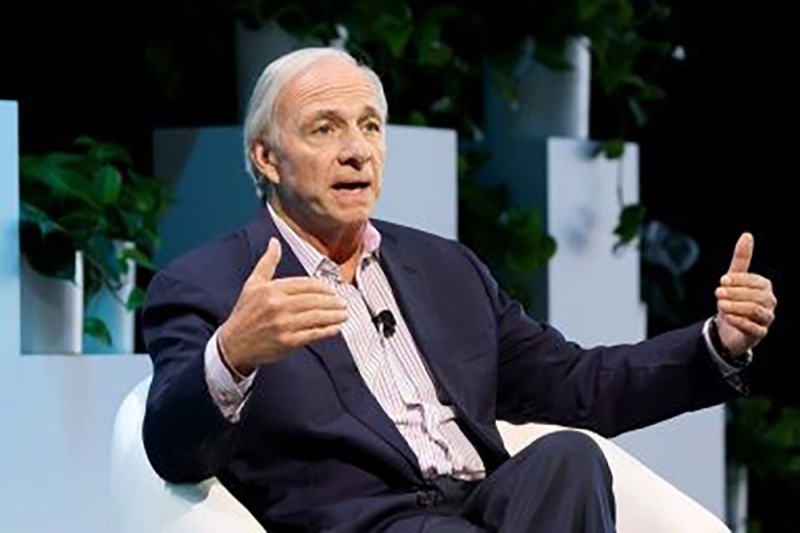
对冲基金亿万富翁瑞·达利欧以对经济和国家债务发出严厉警告而闻名,他近日发出了迄今为止最为严厉的警告:将美国日益严峻的债务危机比作即将到来的“经济心脏病发作”,并敦促政策制定者重新审视20世纪90年代经济繁荣时期的财政纪律。随着美国国债逼近37万亿美元、联邦赤字持续膨胀,两党对国家财政健康状况的忧虑与日俱增,达利欧通过一系列社交媒体帖子和访谈(包括与《财富》杂志黛安·布雷迪(Diane Brady)的对话)敲响了警钟。
作为全球最大对冲基金桥水基金的创始人,达利欧用极具冲击力且生动的表述描述了美国的赤字螺旋。“我们的支出比收入高出40%,这是一个长期存在的问题,”他在最近接受福克斯商业频道采访时说,“你们会看到债务利息支付……正不断挤压购买力,就像动脉中的斑块一样。”
这一类比凸显了一个严峻现实:债务利息支付在政府支出中的占比不断攀升,正挤占其他优先事项的资金。达利欧警告称,美国正逐步逼近一个临界点,届时将不得不发行新债以支付现有债务的利息——他认为这一循环不仅可能引发金融震荡,还可能导致类似心脏骤停的系统性崩溃。他认为,美国必须回到过去——回到90年代。
复苏蓝图
达利欧认为,只要国家上下齐心、坚定决心,就仍能寻得破局之道。他将90年代视为两党携手共克难题、推行财政紧缩政策并实现经济均衡增长的典范。“如果能在经济态势良好之际,将支出与收入(税收所得)的差额下调4%,”他在X上写道,“利率就会随之下降,我们的处境也将大为改善。”他补充道,这种平衡是可以实现的,因为历史已有先例——1991年至1998年间,通过支出控制和针对性税收措施,美国在90年代重新实现了财政平衡。
达利欧建议,通过将联邦赤字降至国内生产总值(GDP)的3%——克林顿执政时期维持的水平——美国就能稳定市场、控制利息支出,进而规避危机。在7月初接受美国全国广播公司财经频道(CNBC)采访时,达利欧估计,倘若债务问题未得到妥善处理,引发金融“重创”的可能性超过50%。
过往警示
这绝非达利欧首次就美国经济状况发出严厉警告。过去五年间,他多次表达对因应对疫情引发的金融冲击而产生的债务、通胀与滞胀问题,乃至即将到来的经济衰退的担忧。尽管自2020年新冠疫情致使经济崩盘以来,经济衰退尚未真正到来,但达利欧警告称,资产价格上涨并未创造真正的财富,因为通胀正不断侵蚀购买力。
达利欧的警告始终围绕一个核心主题:“病症或许比疗法更糟”。他批评政策制定者往往只在通胀失控、美元价值大幅缩水时才采取行动。自2024年起,他多次以“心脏病发作”和“动脉斑块”作类比,批判当前的经济状况。
尽管提出了明确的解决方案,达利欧对当前政治局势能否促成妥协或做出必要抉择持怀疑态度。“我担心,出于政治层面的考量,我们可能无法推行这些必要的削减举措。”他在X上写道,并警告称政府的绝对主义可能使整顿国家财政的种种努力付诸东流。
达利欧认为,其后果将极为严重且影响深远:政府持续超支、债务利息负担加重、美国国债购买者信心丧失。他表示,这种局面可能升级为他所说的“严重供需失衡”——市场不再愿意以可持续利率为美国的借贷习惯提供资金,进而引发具有全球冲击力的金融危机。4月10年期国债市场的下跌,正是外国投资者拒绝为美国借贷习惯“买单”的一个信号,他们似乎因特朗普总统计划实施的关税力度远超预期而心生犹豫。
达利欧反复提及90年代,并非出于怀旧,而是呼吁两党务实合作、共同做出牺牲。他警告称,倘若不在当下经济尚算稳定的时期采取行动,未来改革一旦迫在眉睫,必将付出更为高昂的代价(承受更多痛苦)。尽管达利欧未就此置评,但2025年全年美国债务状况实则持续恶化,国会通过的立法将在未来数年进一步扩大债务规模。据国会预算办公室测算,特朗普的《大而美法案》将在未来十年使赤字增加3.4万亿美元。
为撰写本报道,《财富》杂志使用生成式人工智能协助完成初稿。在发布前,编辑已核实信息准确性。(*)
译者:中慧言-王芳
对冲基金亿万富翁瑞·达利欧以对经济和国家债务发出严厉警告而闻名,他近日发出了迄今为止最为严厉的警告:将美国日益严峻的债务危机比作即将到来的“经济心脏病发作”,并敦促政策制定者重新审视20世纪90年代经济繁荣时期的财政纪律。随着美国国债逼近37万亿美元、联邦赤字持续膨胀,两党对国家财政健康状况的忧虑与日俱增,达利欧通过一系列社交媒体帖子和访谈(包括与《财富》杂志黛安·布雷迪(Diane Brady)的对话)敲响了警钟。
作为全球最大对冲基金桥水基金的创始人,达利欧用极具冲击力且生动的表述描述了美国的赤字螺旋。“我们的支出比收入高出40%,这是一个长期存在的问题,”他在最近接受福克斯商业频道采访时说,“你们会看到债务利息支付……正不断挤压购买力,就像动脉中的斑块一样。”
这一类比凸显了一个严峻现实:债务利息支付在政府支出中的占比不断攀升,正挤占其他优先事项的资金。达利欧警告称,美国正逐步逼近一个临界点,届时将不得不发行新债以支付现有债务的利息——他认为这一循环不仅可能引发金融震荡,还可能导致类似心脏骤停的系统性崩溃。他认为,美国必须回到过去——回到90年代。
复苏蓝图
达利欧认为,只要国家上下齐心、坚定决心,就仍能寻得破局之道。他将90年代视为两党携手共克难题、推行财政紧缩政策并实现经济均衡增长的典范。“如果能在经济态势良好之际,将支出与收入(税收所得)的差额下调4%,”他在X上写道,“利率就会随之下降,我们的处境也将大为改善。”他补充道,这种平衡是可以实现的,因为历史已有先例——1991年至1998年间,通过支出控制和针对性税收措施,美国在90年代重新实现了财政平衡。
达利欧建议,通过将联邦赤字降至国内生产总值(GDP)的3%——克林顿执政时期维持的水平——美国就能稳定市场、控制利息支出,进而规避危机。在7月初接受美国全国广播公司财经频道(CNBC)采访时,达利欧估计,倘若债务问题未得到妥善处理,引发金融“重创”的可能性超过50%。
过往警示
这绝非达利欧首次就美国经济状况发出严厉警告。过去五年间,他多次表达对因应对疫情引发的金融冲击而产生的债务、通胀与滞胀问题,乃至即将到来的经济衰退的担忧。尽管自2020年新冠疫情致使经济崩盘以来,经济衰退尚未真正到来,但达利欧警告称,资产价格上涨并未创造真正的财富,因为通胀正不断侵蚀购买力。
达利欧的警告始终围绕一个核心主题:“病症或许比疗法更糟”。他批评政策制定者往往只在通胀失控、美元价值大幅缩水时才采取行动。自2024年起,他多次以“心脏病发作”和“动脉斑块”作类比,批判当前的经济状况。
尽管提出了明确的解决方案,达利欧对当前政治局势能否促成妥协或做出必要抉择持怀疑态度。“我担心,出于政治层面的考量,我们可能无法推行这些必要的削减举措。”他在X上写道,并警告称政府的绝对主义可能使整顿国家财政的种种努力付诸东流。
达利欧认为,其后果将极为严重且影响深远:政府持续超支、债务利息负担加重、美国国债购买者信心丧失。他表示,这种局面可能升级为他所说的“严重供需失衡”——市场不再愿意以可持续利率为美国的借贷习惯提供资金,进而引发具有全球冲击力的金融危机。4月10年期国债市场的下跌,正是外国投资者拒绝为美国借贷习惯“买单”的一个信号,他们似乎因特朗普总统计划实施的关税力度远超预期而心生犹豫。
达利欧反复提及90年代,并非出于怀旧,而是呼吁两党务实合作、共同做出牺牲。他警告称,倘若不在当下经济尚算稳定的时期采取行动,未来改革一旦迫在眉睫,必将付出更为高昂的代价(承受更多痛苦)。尽管达利欧未就此置评,但2025年全年美国债务状况实则持续恶化,国会通过的立法将在未来数年进一步扩大债务规模。据国会预算办公室测算,特朗普的《大而美法案》将在未来十年使赤字增加3.4万亿美元。
为撰写本报道,《财富》杂志使用生成式人工智能协助完成初稿。在发布前,编辑已核实信息准确性。(*)
译者:中慧言-王芳
Hedge fund billionaire Ray Dalio is known for his dire warnings about the economy and the national debt, but he just issued one of his starkest warnings to date, likening the United States’ mounting debt crisis to an impending “economic heart attack” and urging policymakers to revisit the fiscal discipline that characterized the 1990s boom years. Dalio’s alarm, sounded in a series of social media posts and interviews, including with Fortune’s Diane Brady, comes as the national debt nears $37 trillion and the federal deficit continues to swell, fueling bipartisan anxieties about the country’s financial health.
Dalio, founder of the world’s largest hedge fund, Bridgewater Associates, described America’s deficit spiral in dramatic—and visceral—terms. “We’re spending 40% more than we’re taking in, and this is a chronic problem,” he said in a recent appearance on Fox Business. “What you’re seeing is the debt service payments … well into squeezing away, so it’s like plaque in the arteries squeezing away buying power.”
The analogy underscores a grim reality: Debt service payments have ballooned as a share of government spending, increasingly crowding out funds for other priorities. Dalio warns the U.S. is near a tipping point where it must issue new debt merely to pay interest on existing obligations—a cycle that he says could trigger not just a financial shock but a systemic breakdown reminiscent of cardiac arrest. We’ve got to go back, he argues—back to the ’90s.
A blueprint for recovery
Dalio contends that there is still a way out—as long as the country acts with unity and resolve. He points to the ’90s as a model for bipartisan problem-solving, fiscal restraint, and balanced economic growth. “If we change spending and income (tax returns) by 4% while the economy is still good,” he wrote on Twitter, “the interest rate will go down as a result, and we’ll be in a much better situation.” He added that we know this kind of balance can happen because it happened before, from 1991 to 1998, referencing how both spending controls and targeted tax measures restored equilibrium in the 1990s.
Dalio suggests that by trimming the federal deficit to 3% of GDP—levels last sustained during the Clinton era—the U.S. could stabilize markets, tame interest payments, and avoid a crisis. In a CNBC appearance in early July, Dalio put the odds at over 50% that a financial “trauma” will result from the debt not being dealt with properly.
Past warnings
This is far from the first dire warning to come from Dalio on the state of the U.S. economy. In the past five years, he has voiced concerns about the debt created to fight the financial effects of the pandemic, both inflation and stagflation, and even a looming recession. Although a recession has not set in since the COVID-related crash of 2020, Dalio warned that rising asset prices weren’t creating real wealth, as inflation was eroding purchasing power.
A consistent theme of Dalio’s warnings is that the disease may be worse than the cure, criticizing policymakers likely to act only when inflation became critical and the dollar’s value had materially eroded. He has voiced variations of his “heart attack” and “plaque” critique since 2024.
Despite offering a clear prescription, Dalio expresses skepticism that current political dynamics will allow for compromise or the hard choices required. “My fear is that we will probably not make these needed cuts due to political reasons,” he wrote on Twitter, warning that absolutism in Washington could doom efforts to put the country’s fiscal house in order.
The consequences, Dalio argues, would be severe and far-reaching: sustained government overspending, rising debt service burdens, and a loss of confidence among buyers of U.S. Treasuries. This scenario, he says, could escalate into what he calls a “serious supply-demand problem,” where the market refuses to fund America’s borrowing habits at sustainable rates, catalyzing a financial crisis with global shock waves. The April fall in the 10-year Treasury bond market was a tremor of just such a refusal from foreign investors, who seemed to balk at President Donald Trump’s planned tariffs being much more aggressive than expected.
Dalio’s repeated invocations of the 1990s are more than nostalgia—they are a call to bipartisan pragmatism and shared sacrifice. He warns that failure to act now, with the economy still on stable footing, will only raise the costs (and pain) of inevitable reforms. Although Dalio did not comment on it, the debt situation has actually worsened throughout 2025, with legislation passing through Congress that is set to expand the debt for years to come. Trump’s One Big Beautiful Bill Act will add $3.4 trillion to deficits over the next decade, according to the Congressional Budget Office.
For this story, Fortune used generative AI to help with an initial draft. An editor verified the accuracy of the information before publishing.

